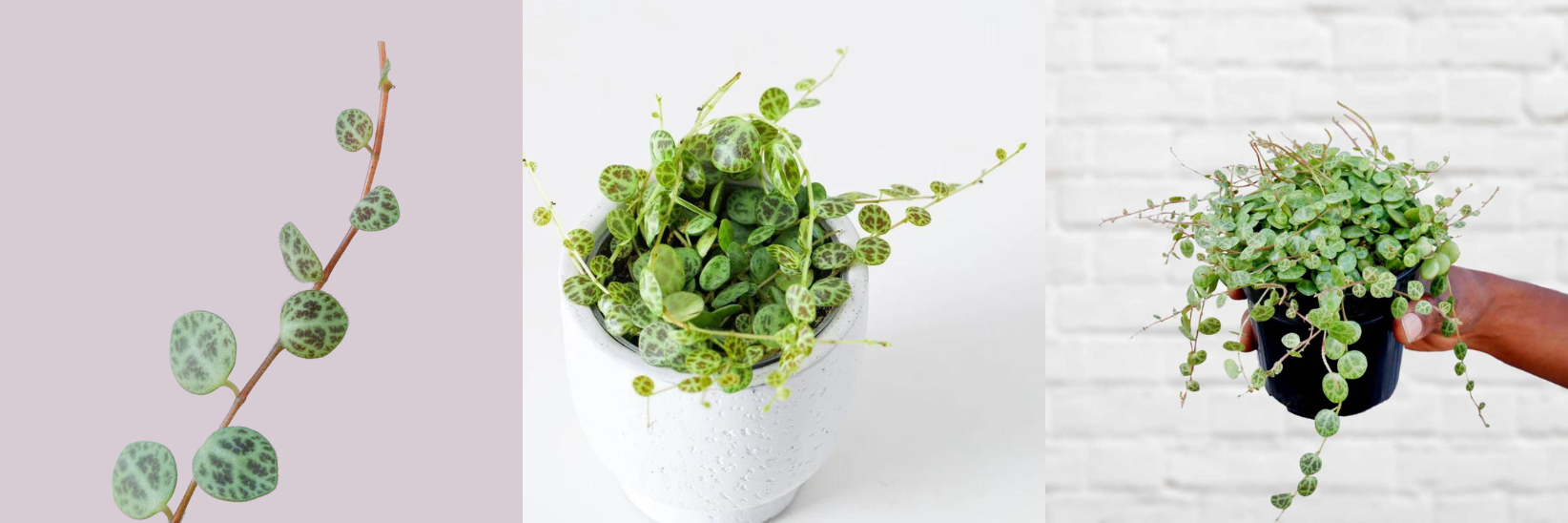String of Turtles Care Instructions
Scientific Name: Peperomia Prostrata
Synonyms: Turtle Plant, Magic Marmer, Radiator Plant, Trailing Peperomia, Turtle Vine, Chain of Turtles.
Step into the enchanting world of Peperomia Prostrata, affectionately known as the String of Turtles. Originating from the lush tropical jungles of Ecuador, this coveted member of the Peperomia family casts a spell with its exquisite foliage, which resembles an intricate turtle shell.
They are excellent choices for a hanging display because of their trailing nature, which creates a delicate cascade over time. It is a slow grower, making it an excellent choice for smaller spaces.
The String of Turtles adores basking in bright, indirect light and appreciates high humidity, while still boasting minimal watering needs. Perfect for bright bathrooms, kitchens, and terrariums.
Unleash your creativity in styling—whether it's a chic planter gracing a shelf, a whimsical addition to a hanging display, or a captivating centrepiece on a tabletop, the String of Turtles promises to captivate hearts with its irresistible charm and unparalleled beauty.
Toxicity: Peperomia is not considered toxic, but prefers not to be a snack item..

String of Turtles Peperomia Common Symptoms
- Yellowing leaves: This can signal a few issues, the most common being: overwatering, lack of fertilisation, or lack of light. Be sure to check the moisture level in the soil, and that your planter is draining properly. If you find the soil to be soggy, reduce the frequency of watering. If you have checked environmental factors and all is in order, consider feeding with a well balanced fertiliser such as Biotrissol.
- Leaf drop: This is most prevalent in underwatered plants, but can happen with overwatering too. If you notice crisp, dry leaves as well, then water more frequently. Peperomia Prostrata does not like drying out completely, and watering should take place the moment the soil just feels moist to the touch. Think wrung out tea towel.
- Curling, faded, or crispy foliage: Curling, light brown, or dry leaves indicate underwatering and/or low humidity. Ensure your plant receives adequate water and consider placing it on a tray of pebbles with water to increase humidity levels.
- No growth: Peperomia plants generally prefer moderate-to-bright indirect light. Lack of new growth may indicate insufficient sunlight. Consider relocating your plant to a brighter spot with indirect sunlight to encourage growth.
- Brown and Mushy Stems or Leaves: Soft, mushy stems with brown discoloration suggest root rot. Re-pot the plant in fresh, well-draining soil, trimming any affected roots. Reduce watering frequency and provide adequate light to promote root recovery.
-
Pests: Like most houseplants, Peperomia Prostrata is prone to pests when not provided with optimal conditions. To keep your plant healthy, strive to replicate its natural environment as closely as possible. Mealybugs and Fungus Gnats are common pests attracted to it due to their preference for warm, moist settings. However, other household pests may also pose a threat. Promptly address any pest outbreaks and avoid neglecting your plant's care routine. Treat with Pyrol or Neusodan, and isolate the plant to prevent pests from spreading to other plants. Regularly wipe down leaves with a damp cloth to remove dust and discourage pest infestations. To identify pests, have a look at our: Pest Identification Blog.
String of Turtles Peperomia Care Instructions
- Origin: South America, namely Ecuador.
- Height: Average 30cm in length and Width
- Light: Bright, filtered light is best. Avoid harsh, direct sunlight. Will tolerate gentle, direct morning sunlight.
- Water: Keep soil very evenly moist, and avoid overly dry or overly soggy potting soil.
- Humidity: preferably 50% or higher. To raise the humidity for your plant. Spritz it daily, and place a plant on a pebble tray. Will also tolerate average room humidity if care is taken with watering.
- Temperature: Peperomia prefers warm environments between 17 °C and 27°C.
- Soil: A very well-draining organic medium that will hold onto some water.
- Fertiliser: Fertilise every two weeks from spring to autumn with a balanced liquid fertiliser.
- Pruning: Pruning Peperomia involves removing dead or damaged leaves and stems to maintain plant health and shape. Use clean, sharp scissors or pruning shears to make precise cuts. Regular pruning encourages bushier growth and prevents overcrowding. Focus on removing any yellowing or discoloured foliage and trimming back leggy stems to promote a compact, lush appearance.
- Repotting: Repotting your Peperomia Prostrata is essential for its continued health and growth. Choose a slightly larger pot (maximum 3cm-5cm larger) with drainage holes to accommodate its roots. Gently remove the plant from its current pot, loosen the roots, and place it into the new container with fresh, well-draining soil. Ensure the plant sits at the same depth as before. Water thoroughly and resume regular care. Repotting every 1-2 years or when roots outgrow the pot promotes healthy growth and prevents root-bound conditions.
- Propagation: Propagating Peperomia Prostrata is straightforward. Utilise stem cuttings, ensuring each cutting has at least one leaf node. Remove the lower leaves to expose the node and promote root growth. Dip the cut end in rooting hormone (optional) and plant it in a well-draining potting mix. Keep the soil consistently moist but not waterlogged. Place the cuttings in a warm, bright location with indirect sunlight. With patience, roots will develop within a few weeks. Once rooted, transplant the cuttings into their own pots, 10–15 cuttings per pot for best results, and continue caring for them as you would a mature plant.
If in stock, shop for String of Turtles here.



